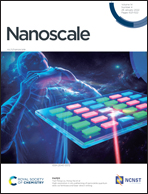Lattice distortion of crystalline-amorphous nickel molybdenum sulfide nanosheets for high-efficiency overall water splitting: libraries of lone pairs of electrons and in situ surface reconstitution†
Abstract
Lattice distortion is an important way to improve the electrocatalytic performance and stability of two-dimensional transition metal materials (2d-TMSs). Herein, a lattice distortion nickel-molybdenum sulfide electrocatalyst on foam nickel (NiMoS4-12/NF) has been synthesized through a novel, simple, and effective crystalline-amorphous strategy. The electrocatalyst only requires 1.47 V to obtain 10 mA cm−2 for overall water splitting (OWS) and can function stably for 100 h at a current density of 100 mA cm−2, demonstrating an excellent electrocatalytic performance and stability. From the results of the transmission electron microscopy (TEM) and electron paramagnetic resonance spectroscopy (EPR), it can be seen that the (104) crystal lattice of NiMoS4-12 undergoes interface strain under the crystalline-amorphous state, resulting in rich sulfur defects caused by lattice distortion, which could improve the intrinsic catalytic activity of NiMoS4-12. According to the differential charge density analysis, around the sulfur defects, the Mo and Ni atoms with abundant lone pairs of electrons acted as libraries of lone pairs of electrons to enable an efficient hydrogen evolution reaction (HER). From the total density of states (TDOS) and the Gibbs free energy of hydrogen adsorption (ΔGH*), the libraries of lone pairs of electrons not only effectively optimized the distribution of the surface electron density of states at the Fermi level, but also reduced the ΔGH*, thereby improving the intrinsic HER electrocatalytic performance. The in situ Raman test results demonstrate that during the oxygen evolution reaction (OER), the surface of the nickel molybdenum sulfide was reconstructed, and highly active Ni-OOH was generated. From the calculated free energy diagrams, the Ni-OOH could optimize the reaction barrier of the rate-determining step (RDS) for the OER to enhance the slow oxygen evolution reaction kinetics. This work will contribute to the rational design of a 2d-TMSs electrocatalyst, as well as investigation of the catalytic mechanism.



 Please wait while we load your content...
Please wait while we load your content...